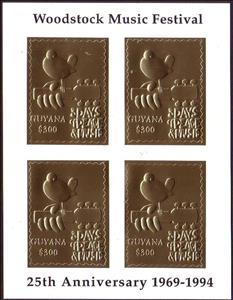Full Pane: Poster from 1969 (Guyana 1994)
Poster from 1969 (Guyana 1994)
10 February (Guyana ) within release 25th Anniversary of the Woodstock Festival goes into circulation Full Pane Poster from 1969 face value 4*300 Guyanese dollar
| Full Pane Poster from 1969 in catalogues | |
|---|---|
| Colnect codes: | Col: GY 1994.02.10-41b |
Full Pane is square format.
Also in the issue 25th Anniversary of the Woodstock Festival:
- Stamp - Poster from 1969 face value 300;
- Stamp - Poster from 1969 face value 300;
- Stamp - Poster from 1969 face value 300;
- Full Pane - Poster from 1969 face value 4*300;
- Full Pane - Poster from 1969 face value 4*300;
- Full Pane - Poster from 1969 face value 4*300;
- Souvenir Sheet - Poster from 1969 face value 300;
- Souvenir Sheet - Poster from 1969 face value 300;
- Souvenir Sheet - Poster from 1969 face value 300;
- Stamp - Poster from 1969 face value 300;
- Stamp - Poster from 1969 face value 300;
- Stamp - Poster from 1969 face value 300;
- Souvenir Sheet - Poster from 1969 face value 300;
- Souvenir Sheet - Poster from 1969 face value 300;
- Souvenir Sheet - Poster from 1969 face value 300;
- Stamp - Poster from 1994 face value 300;
- Stamp - Poster from 1994 face value 300;
- Stamp - Poster from 1994 face value 300;
- Souvenir Sheet - Poster from 1994 face value 300;
- Souvenir Sheet - Poster from 1994 face value 300;
- Souvenir Sheet - Poster from 1994 face value 300;
|
Data entry completed
50%
|
|
|---|---|
| Full Pane Poster from 1969 in digits | |
| Country: | Guyana |
| Date: | 1994-02-10 |
| Perforation: | Simulated |
| Emission: | Commemorative |
| Format: | Full Pane |
| Face Value: | 4*300 Guyanese dollar |
Full Pane Poster from 1969 it reflects the thematic directions:
Birds (Aves), a subgroup of Reptiles, are the last living examples of Dinosaurs. They are a group of endothermic vertebrates, characterised by feathers, toothless beaked jaws, the laying of hard-shelled eggs, a high metabolic rate, a four-chambered heart, and a strong yet lightweight skeleton. Birds live worldwide and range in size from the 5 cm (2 in) bee hummingbird to the 2.75 m (9 ft) ostrich. They rank as the class of tetrapods with the most living species, at approximately ten thousand, with more than half of these being passerines, sometimes known as perching birds. Birds are the closest living relatives of crocodilians.
A festival is an event celebrated by a community and centering on some characteristic aspect or aspects of that community and its religion or cultures. It is often marked as a local or national holiday, mela, or eid. A festival constitutes typical cases of glocalization, as well as the high culture-low culture interrelationship. Next to religion and folklore, a significant origin is agricultural. Food is such a vital resource that many festivals are associated with harvest time. Religious commemoration and thanksgiving for good harvests are blended in events that take place in autumn, such as Halloween in the northern hemisphere and Easter in the southern.
Music is an art form and cultural activity whose medium is sound organized in time. The common elements of music are pitch (which governs melody and harmony), rhythm (and its associated concepts tempo, meter, and articulation), dynamics (loudness and softness), and the sonic qualities of timbre and texture (which are sometimes termed the "color" of a musical sound). Different styles or types of music may emphasize, de-emphasize or omit some of these elements. Music is performed with a vast range of instruments and vocal techniques ranging from singing to rapping; there are solely instrumental pieces, solely vocal pieces (such as songs without instrumental accompaniment) and pieces that combine singing and instruments. The word derives from Greek μουσική (mousike; "art of the Muses"). In its most general form, the activities describing music as an art form or cultural activity include the creation of works of music (songs, tunes, symphonies, and so on), the criticism of music, the study of the history of music, and the aesthetic examination of music. Ancient Greek and Indian philosophers defined music as tones ordered horizontally as melodies and vertically as harmonies. Common sayings such as "the harmony of the spheres" and "it is music to my ears" point to the notion that music is often ordered and pleasant to listen to.
A musical instrument is a device created or adapted to make musical sounds. In principle, any object that produces sound can be considered a musical instrument—it is through purpose that the object becomes a musical instrument. A person who plays a musical instrument is known as an instrumentalist. The history of musical instruments dates to the beginnings of human culture. Early musical instruments may have been used for rituals, such as a horn to signal success on the hunt, or a drum in a religious ceremony. Cultures eventually developed composition and performance of melodies for entertainment. Musical instruments evolved in step with changing applications and technologies.
A poster is a large sheet that is placed either on a public space to promote something or on a wall as decoration. Typically, posters include both textual and graphic elements, although a poster may be either wholly graphical or wholly text. Posters are designed to be both eye-catching and informative. Posters may be used for many purposes. They are a frequent tool of advertisers (particularly of events, musicians, and films), propagandists, protestors, and other groups trying to communicate a message. Posters are also used for reproductions of artwork, particularly famous works, and are generally low-cost compared to the original artwork. The modern poster, as we know it, however, dates back to the 1840s and 1850s when the printing industry perfected colour lithography and made mass production possible




